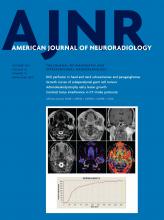Research ArticleAdult Brain
Alterations in the Magnetoencephalography Default Mode Effective Connectivity following Concussion
D.D. Reddy, E.M. Davenport, F.F. Yu, B. Wagner, J.E. Urban, C.T. Whitlow, J.D. Stitzel and J.A. Maldjian
American Journal of Neuroradiology October 2021, 42 (10) 1776-1782; DOI: https://doi.org/10.3174/ajnr.A7232
D.D. Reddy
aFrom the Department of Radiology (D.D.R., E.M.D., F.F.Y., B.W., J.A.M.), University of Texas Southwestern, Dallas, Texas
E.M. Davenport
aFrom the Department of Radiology (D.D.R., E.M.D., F.F.Y., B.W., J.A.M.), University of Texas Southwestern, Dallas, Texas
F.F. Yu
aFrom the Department of Radiology (D.D.R., E.M.D., F.F.Y., B.W., J.A.M.), University of Texas Southwestern, Dallas, Texas
B. Wagner
aFrom the Department of Radiology (D.D.R., E.M.D., F.F.Y., B.W., J.A.M.), University of Texas Southwestern, Dallas, Texas
J.E. Urban
bWake Forest School of Medicine (J.E.U. C.T.W., J.D.S.), Winston-Salem, North Carolina
C.T. Whitlow
bWake Forest School of Medicine (J.E.U. C.T.W., J.D.S.), Winston-Salem, North Carolina
J.D. Stitzel
bWake Forest School of Medicine (J.E.U. C.T.W., J.D.S.), Winston-Salem, North Carolina
J.A. Maldjian
aFrom the Department of Radiology (D.D.R., E.M.D., F.F.Y., B.W., J.A.M.), University of Texas Southwestern, Dallas, Texas

References
- 1.↵
- 2.↵
- McCrea M,
- Guskiewicz KM,
- Marshall SW, et al
- 3.↵
- 4.↵
- Huang MX,
- Theilmann RJ,
- Robb A, et al
- 5.↵
- Zhu DC,
- Covassin T,
- Nogle S, et al
- 6.↵
- Fibel K,
- Cardinale N,
- Nichols S, et al
- 7.↵
- Brookes MJ,
- Woolrich M,
- Luckhoo H, et al
- 8.↵
- Dale AM,
- Liu AK,
- Fischl BR, et al
- 9.↵
- 10.↵
- 11.↵
- Lee RR,
- Huang M
- 12.↵
- 13.↵
- 14.↵
- 15.↵
- 16.↵
- 17.↵
- 18.↵
- 19.↵
- Sharp DJ,
- Beckmann CF,
- Greenwood R, et al
- 20.↵
- Raichle ME,
- MacLeod AM,
- Snyder AZ, et al
- 21.↵
- 22.↵
- 23.↵
- Ashburner J,
- Friston KJ
- 24.↵
- 25.↵
- Hämäläinen MS,
- Ilmoniemi RJ
- 26.↵
- Desikan RS,
- Ségonne F,
- Fischl B, et al
- 27.↵
- 28.↵
- Hillebrand A,
- Tewarie P,
- Van Dellen E, et al
- 29.↵
- Granger CW
- 30.↵
- Geweke J
- 31.↵
- 32.↵
- Mayer AR,
- Mannell MV,
- Ling J, et al
- 33.↵
- 34.↵
- 35.↵
- 36.↵
- 37.↵
- de Almeida JR,
- Versace A,
- Mechelli A, et al
- 38.↵
- Liu Z,
- Zhang Y,
- Bai L, et al
- 39.↵
- 40.↵
- 41.↵
- 42.↵
- 43.↵
- 44.↵
- Gorman LK,
- Fu K,
- Hovda DA, et al
- 45.↵
- Schaul N,
- Gloor P,
- Ball G, et al
- 46.↵
In this issue
American Journal of Neuroradiology
Vol. 42, Issue 10
1 Oct 2021
Advertisement
D.D. Reddy, E.M. Davenport, F.F. Yu, B. Wagner, J.E. Urban, C.T. Whitlow, J.D. Stitzel, J.A. Maldjian
Alterations in the Magnetoencephalography Default Mode Effective Connectivity following Concussion
American Journal of Neuroradiology Oct 2021, 42 (10) 1776-1782; DOI: 10.3174/ajnr.A7232
0 Responses
Jump to section
Related Articles
- No related articles found.
Cited By...
This article has been cited by the following articles in journals that are participating in Crossref Cited-by Linking.
- Natalie M. Bell, Fang F. Yu, Yin Xi, Amy L. Proskovec, James M. Holcomb, Sahil Chilukuri, Jillian E. Urban, Christopher Vaughan, Jesse C. DeSimone, Ben Wagner, Mark A. Espeland, Alexander K. Powers, Christopher T. Whitlow, Joel D. Stitzel, Joseph A. Maldjian, Elizabeth M. DavenportJournal of Neurotrauma 2025
More in this TOC Section
Adult Brain
Similar Articles
Advertisement











